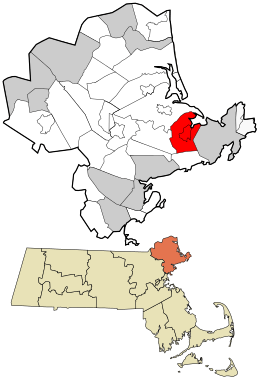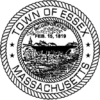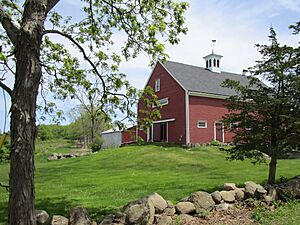Essex, Massachusetts facts for kids
Quick facts for kids
Essex, Massachusetts
|
|||
|---|---|---|---|

Essex in early autumn, showing the Essex River and surrounding wetlands
|
|||
|
|||

Location in Essex County and the state of Massachusetts.
|
|||
| Country | United States | ||
| State | Massachusetts | ||
| County | Essex | ||
| Settled | 1634 | ||
| Incorporated | 1819 | ||
| Government | |||
| • Type | Open town meeting | ||
| Area | |||
| • Total | 15.9 sq mi (41.3 km2) | ||
| • Land | 14.0 sq mi (36.2 km2) | ||
| • Water | 2.0 sq mi (5.1 km2) | ||
| Elevation | 26 ft (8 m) | ||
| Population
(2020)
|
|||
| • Total | 3,675 | ||
| • Density | 230.47/sq mi (88.98/km2) | ||
| Time zone | UTC-5 (Eastern) | ||
| • Summer (DST) | UTC-4 (Eastern) | ||
| ZIP code |
01929
|
||
| Area code(s) | 351 / 978 | ||
| FIPS code | 25-21850 | ||
| GNIS feature ID | 0618296 | ||
Essex is a small coastal town in Essex County, Massachusetts, United States. It is located about 26 miles (42 km) north of Boston. The town is famous for its history as a center for shipbuilding. In 2020, about 3,675 people lived there.
The main parts of Essex, including the central village and South Essex, form a special area called a census-designated place.
Contents
Exploring Essex's Past
Essex became an official town in 1819. Before that, it was part of Ipswich and was known as Chebacco Parish. The first European settlers arrived in 1634.
Native American Roots
When Europeans first arrived, the land was home to the Agawam tribe of Native Americans. The name Chebacco comes from the Agawam language. It refers to a large lake that stretches into the nearby town of Hamilton. Conomo Point, the easternmost part of Essex, is named after Masconomo. He was the leader, or Sagamore, of the Agawam tribe in the late 1600s.
A Unique Meeting House Story
In colonial times, Chebacco Parish wanted to become an independent town. They asked for permission to build their own meeting house. A meeting house was like a church and community center. Having one meant a settlement was almost independent.
The leaders said "no man shall raise a meeting house." But the clever residents found a loophole! A local woman, Madam Varney, gathered the town's women. They built the meeting house themselves while the men watched. This story shows the strong spirit of the early settlers.
Geography and Getting Around Essex
Essex covers about 15.9 square miles (41.3 sq km). About 14 square miles (36.2 sq km) is land, and 2 square miles (5.1 sq km) is water.
Waterways and Natural Beauty
The town doesn't have direct access to the ocean. Instead, the Essex River flows into Essex Bay, which connects to the ocean. The center of Essex is built on marshland around the Essex River. Other rivers and creeks also feed into Essex Bay.
Most of the town is close to sea level, with a few small hills. Chebacco Lake and its wetlands are in the southwestern part of town. Essex has kept its rural feel with many forests, wetlands, and open spaces. There are several protected areas, like the Allyn-Cox Reservation and parts of the Crane Wildlife Refuge. The Crane Wildlife Refuge includes islands in Essex Bay, like Choate Island.
Connecting to Nearby Towns
Essex shares borders with Hamilton to the west, Manchester-by-the-Sea to the south, Gloucester to the east, and Ipswich to the north. It is about 11 miles (18 km) northeast of Salem and 33 miles (53 km) northeast of Boston.
While no major highways go directly through Essex, Route 128 passes nearby. Route 133 crosses the town, and Route 22 ends in the town center. For public transport, the Ipswich Essex Explorer bus offers weekend service in the summer. It connects to the MBTA Commuter Rail at Ipswich.
Who Lives in Essex?
| Historical population | ||
|---|---|---|
| Year | Pop. | ±% |
| 1850 | 1,585 | — |
| 1860 | 1,701 | +7.3% |
| 1870 | 1,014 | −40.4% |
| 1880 | 1,670 | +64.7% |
| 1890 | 1,713 | +2.6% |
| 1900 | 1,663 | −2.9% |
| 1910 | 1,621 | −2.5% |
| 1920 | 1,478 | −8.8% |
| 1930 | 1,465 | −0.9% |
| 1940 | 1,384 | −5.5% |
| 1950 | 1,794 | +29.6% |
| 1960 | 2,238 | +24.7% |
| 1970 | 2,670 | +19.3% |
| 1980 | 2,998 | +12.3% |
| 1990 | 3,260 | +8.7% |
| 2000 | 3,267 | +0.2% |
| 2010 | 3,504 | +7.3% |
| 2020 | 3,675 | +4.9% |
| 2022* | 3,668 | −0.2% |
| * = population estimate. Source: United States Census records and Population Estimates Program data. |
||
In 2000, there were 3,267 people living in Essex. The town had 1,313 households, with many being families. About 31.5% of households had children under 18. The average household had 2.49 people.
The population was spread out by age. About 24.2% were under 18, and 13.6% were 65 or older. The average age was 40 years. The median income for a household was about $59,554.
Learning in Essex
Essex is part of the Manchester Essex Regional School District.
Local Schools
Essex has one public elementary school, Essex Elementary School. It teaches children from pre-kindergarten to fifth grade. Previously, Essex Middle School taught students up to eighth grade. Now, middle school students attend the Manchester Essex Regional Middle School. This school is in the same building as the Manchester Essex Regional High School.
High School Education
Essex does not have its own high school. For many years, high school students from Essex went to schools in nearby towns. These towns included Manchester-by-the-Sea, Gloucester, and Hamilton-Wenham.
In 2000, Essex and Manchester-by-the-Sea decided to create a regional school district. This meant they would share a school system called "Manchester-Essex Schools." A new high school was built for students from both towns. This was the first time Essex students didn't have to leave their district for high school.
In 2006, voters in both towns approved a $49 million project. This project was to build a new middle school and high school. Construction finished in 2009, and students started attending the new school that fall.
Essex's Economy and Industries
Seafood, Tourism, and Antiques
The main ways Essex makes money are through its shellfish industry and tourism. The famous fried clam recipe was supposedly invented in Essex by Chubby Woodman in the early 1900s. Because of the tasty clams from the Essex River, local seafood restaurants are very popular.
Tourists mostly come to Essex for its restaurants. But other fun activities, like boat trips on the Essex River or kayaking, are also popular. Essex doesn't have an easily accessible beach like its neighbors, so beaches aren't a big draw. However, in recent decades, Essex has become known for its many antique shops. It now has one of the highest numbers of antique shops per town in the United States!
A History of Shipbuilding
Essex was once a very busy place for shipbuilding. This industry brought most of the town's money from its early days until the early 1900s. Essex was a top supplier of schooners, which are sailing ships, for fishing communities along the Atlantic coast.
However, Essex did not switch from wooden sailing ships to metal ships with engines. Because of this, the shipbuilding industry ended around World War II. Today, there are efforts to bring back small-scale shipbuilding as a tourist attraction. The Essex Shipbuilding Museum celebrates this history. The Story Family's boatyard still builds classic wooden ships in the Essex style.
Culture and Community Life
Essex has many active youth sports teams. There are also other youth groups, like the Boy Scouts of America and Girl Scouts of the USA.
From 1994, the Essex Music Festival was held at Centennial Grove at Chebacco Lake. It featured bluegrass, blues, folk, maritime, and Celtic music. The festival was canceled in 2009 and 2011 due to hurricanes and has not been held since.
Part of the movie Grown Ups was filmed at Centennial Grove at Chebacco Lake in 2009.
Places of Worship
Essex has several churches. These include different types of Protestant Christian churches, such as Unitarian Universalist, Congregational, Evangelical, and Bible churches. There is also a Roman Catholic parish.
Conomo Point: A Summer Getaway
Conomo Point is a summer community in Essex that is over 100 years old. It has 104 seasonal cottages and some year-round homes. These homes are on land leased from the town.
How Conomo Point Grew
In 1819, when Essex separated from Ipswich, Essex agreed to care for its poor. To do this, the town found four properties in 1825 that were good for a "Poor Farm" or "Alms House." These waterfront properties were not good for shipyards or farming, so they weren't worth much at the time.
Between 1850 and 1900, people's views on waterfront property changed. This was because work weeks became shorter, and more people joined the middle class. The town then allowed people to lease land to build small cottages, or "shanties." By 1900, Conomo Point was popular with people from other towns too, especially after a railroad was built in Essex in 1892.
Changes and Challenges
Conomo Point residents paid taxes on the land they rented and on their cottages. The town of Essex expected to make money from its land. Rents were increased several times over the years.
From 1950 to 1970, Essex wanted to earn as much rent as possible. They approved new lots for cottages, leading to fast growth at Conomo Point.
By the late 1940s, the water pipes to Conomo Point were old. The water became rusty and cloudy. In the mid-1970s, residents started drilling their own private wells. Because the town's water lines were turned off in October for winter, living there year-round wasn't an option. So, in 1982, the town ruled that no more cottages could be changed from seasonal to year-round use.
Places to Visit in Essex
- Chebacco Lake
- Choate House, where Rufus Choate was born
- Cogswell's Grant, a historic farm from around 1728
- Conomo Point
- Cox Reservation – a conservation area managed by the Essex County Greenbelt Association
- Crane Wildlife Refuge
- Essex Shipbuilding Museum
- Essex Town Hall and TOHP Burnham Library
- First Congregational Church on Main Street; its meetinghouse was built in 1792. It has a bell made by Paul Revere in 1797.
- Stavros Reservation
Famous People from Essex
- Joseph Brain (born 1940), a scientist who studies how the body works and environmental health.
- Rufus Choate (1799–1859), a famous lawyer, speaker, and politician. He served as a U.S. congressman and senator. Choate Street in Essex is named after his family.
- Evan Dando, the founder and lead singer of the rock band The Lemonheads, grew up in Essex.
- Benn Ferriero, an NHL hockey player, was born and raised in Essex.
- Michael Gerald Ford (born 1950), the oldest son of U.S. President Gerald Ford. He lived in Essex while studying at a nearby seminary.
- Annie Gosbee (1935–1976), an amazing athlete and baseball player in the All-American Girls Professional Baseball League. She was born and raised in Essex.
- Jonathan Knight, a member of the 1980s–1990s boy band New Kids on the Block. He now hosts an HGTV show called Farmhouse Fixer, where he restores old New England farmhouses.
- Augustus Gardner Means (1925–1994), a politician who served in the Massachusetts government. He also received a special award for his service in the U.S. Army.
- John Wise (1652–1725), a pastor in Chebacco Parish. He spoke out against "taxation without representation" long before the American Revolutionary War. A part of Massachusetts Route 133, John Wise Avenue, is named after him.
See also
 In Spanish: Essex (Massachusetts) para niños
In Spanish: Essex (Massachusetts) para niños





